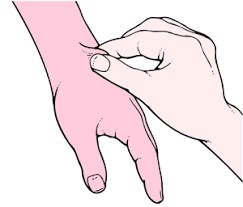While performing a routine assessment, a nurse notices fraying on the electrical cord of a client’s continuous passive motion (CPM) device.
Which of the following actions should the nurse take first?
Report the defect to the equipment maintenance staff.
Remove the device from the room.
Initiate a requisition for a replacement CPM device.
Ensure the device inspection sticker is current.
The Correct Answer is B
The correct answer is b. Remove the device from the room.
Choice A rationale:
- Reporting the defect to the equipment maintenance staff is essential, but it's not the immediate priority. The primary concern is to eliminate the safety hazard posed by the frayed cord to prevent potential harm to the client and others.
- Delaying the removal of the device could lead to electrical shock, fire, or other serious consequences.
- Therefore, removing the device from the room takes precedence over reporting the defect.
Choice B rationale:
- Removing the device from the room is the most appropriate first action because it:
- Eliminates the immediate safety hazard.
- Prevents potential harm to the client and others.
- Protects the device from further damage.
- Ensures the safety of the environment.
- Demonstrates the nurse's prioritization of patient safety.
Choice C rationale:
- Initiating a requisition for a replacement CPM device is necessary to ensure the client's continued treatment.
- However, it's not the first action because it doesn't address the immediate safety concern.
- The nurse should first remove the faulty device and then initiate the process for obtaining a replacement.
Choice D rationale:
- Ensuring the device inspection sticker is current is a vital part of equipment maintenance.
- However, it's not relevant to the immediate safety issue of the frayed cord.
- The presence of a current inspection sticker doesn't guarantee the device's safety or functionality at that moment.
- The nurse must prioritize removing the hazard and then follow up with appropriate documentation and reporting.
Nursing Test Bank
Naxlex Comprehensive Predictor Exams
Related Questions
Correct Answer is D
Explanation
Choice A reason
Abdomen area is not appropriate: Assessing skin turgor on the abdomen is not commonly performed. The abdomen may not be the most accurate site for assessing skin turgor, especially in older adults, as it can be influenced by factors such as body fat distribution.
Choice B reason:
Shoulder are is not appropriate: The shoulder is not a typical site for assessing skin turgor. It is generally not used for this purpose, as it may not provide reliable results
Choice C reason:
Stomach is not the correct answer.: Assessing skin turgor on the stomach is also not commonly performed. The abdomen or stomach may not be the most accurate site for assessing skin turgor, especially in older adults.
Choice D reason
When assessing skin turgor in an older adult client, the nurse should lift the skin on the neck to evaluate its elasticity and hydration status. Skin turgor is a measure of skin's elasticity and is commonly used as an indicator of hydration in both adults and older adults.
To assess skin turgor, the nurse will gently pinch a small amount of skin on the back of the client's hand or the front of the chest (sternum). However, since the options listed do not include these areas, the closest alternative for an older adult would be the neck.

Correct Answer is A
Explanation
The correct answer is choice A. Deep tendon reflexes 2+. This indicates that the client is receiving the therapeutic effect of magnesium sulfate, which is to prevent seizures by reducing neuromuscular excitability.
Magnesium sulfate is a mineral that is given intravenously to women with preeclampsia, a condition of high blood pressure and protein in the urine during pregnancy, to reduce the risk of seizures or eclampsia. It can also prolong pregnancy for up to two days, allowing drugs that speed up the baby’s lung development to be administered.
Choice B is wrong because 1+ proteinuria via urine dipstick is not a therapeutic effect of magnesium sulfate, but a sign of preeclampsia.
Proteinuria indicates that the kidneys are not working properly and are leaking protein into the urine. Magnesium sulfate does not improve the outcomes for the baby and can cause side effects such as respiratory depression for the mother.
Choice C is wrong because pulse rate 100/min is not a therapeutic effect of magnesium sulfate, but a possible side effect.
Magnesium sulfate can cause vasodilation, which lowers blood pressure and increases heart rate. A normal pulse rate for an adult is between 60 and 100 beats per minute. A pulse rate higher than 100 beats per minute may indicate tachycardia, which can be caused by various factors such as anxiety, dehydration, fever, infection, or medication.
Choice D is wrong because urine output 20 mL/hr is not a therapeutic effect of magnesium sulfate, but a sign of kidney failure. A normal urine output for an adult is between 800 and 2000 mL per day, or about 30 to 80 mL per hour. A urine output lower than 30 mL per hour may indicate oliguria, which can be caused by various factors such as dehydration, blood loss, shock, or kidney damage. Magnesium sulfate can cause renal toxicity if given in high doses or for prolonged periods.
Whether you are a student looking to ace your exams or a practicing nurse seeking to enhance your expertise , our nursing education contents will empower you with the confidence and competence to make a difference in the lives of patients and become a respected leader in the healthcare field.
Visit Naxlex, invest in your future and unlock endless possibilities with our unparalleled nursing education contents today
Report Wrong Answer on the Current Question
Do you disagree with the answer? If yes, what is your expected answer? Explain.
Kindly be descriptive with the issue you are facing.
